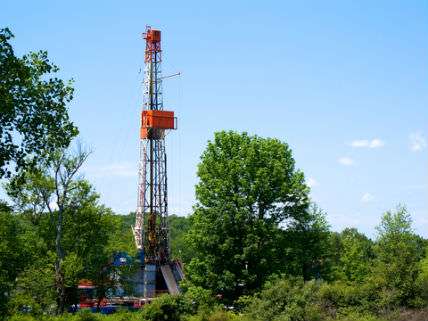Fracking Fearmongering: Another "Regulatory Science" Confirmation
Science: Searching really hard until you find what you want?

The New York Times is reporting a new study in the Proceedings of the National Academy of Sciences that purports to find contamination in drinking water by 2-n-Butoxyethanol (2-BE). 2-BE is a compound sometimes used in fracking fluids used to crack open deep shale to release natural gas. The Times reports:
"This is the first case published with a complete story showing organic compounds attributed to shale gas development found in a homeowner's well," said Susan Brantley, one of the study's authors and a geoscientist from Pennsylvania State University.
"Complete story" is a pretty good summation of their findings. Why? Because the contamination was not the result of fracking itself. It was either the result of a 2009 surface tank leak or a faulty well-casing—the compound did not travel upward from the layers of shale through thousands of feet of rock to surface aquifers. In their supplmental information, the researchers note, "Although not expected to be significant, release of 2-BE could also result from consumer product use, such as out-door use of liquid cleaners and paints." Perhaps so, but how confident can they really be that that is not a source for the 2-BE? After all, the contamination "was measured in parts per trillion, [and] was within safety regulations and did not pose a health risk."
It's perhaps unfair, but studies involved with the possible assertion of regulatory authority bring to mind the joke in which a statistician is asked what the result of a calculation is? He replies, "What do you want it to be?"
Of course, surface tank leaks and faulty well-casings happen with conventional gas and oil drilling and if they produce contamination that harms property owners, they should be fully compensated. The Times quotes industry representatives:
Katie Brown, an energy consultant with Energy in Depth, an advocacy group for the Independent Petroleum Association of America, said the authors had no evidence that the small traces they found of 2-BE, which is also used in many household items, came from a drilling site.
"The entire case is based around the detection of an exceedingly small amount of a compound that's commonly used in hundreds of household products," Ms. Brown wrote in an email. "The researchers suggest the compound is also found in a specific drilling fluid, but then tell us they have no evidence that this fluid was used at the well site."
The EPA is currently in the midst of conducting a study aimed at "elucidat[ing] the relationship, if any, between hydraulic fracturing and drinking water resources." The agency claims that it is "committed to conducting a study that uses the best available science, independent sources of information, and a transparent, peer-reviewed process that will ensure the validity and accuracy of the results."
In my column, Is Regulatory Science Oxymoronic?, I asked:
A final couple of questions: Why is it that environmentalists and environmental agency bureaucrats can always gin up studies that show that any activity they oppose and/or want to regulate is dangerous to the environment? On the other hand, why is it that energy producers and energy agency bureaucrats can gin up studies that suggest that the benefits of any activity they favor outweigh the costs?
Tentative answer: Regulatory science is an oxymoron.
That is still my answer.

Show Comments (41)